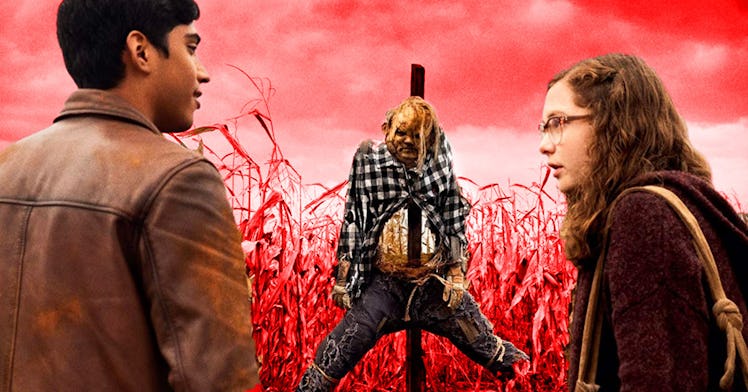‘Scary Stories’ Proves Kids’ Horror Movies Don’t Have to Suck
The new film based on the classic books isn't the best horror movie ever. But it might be the best children's horror movie ever.

Lots of kids like to be scared, but they probably shouldn’t be watching The Exorcist. Making a kid-friendly horror movie is a tricky task because it needs to be scary but not too scary. A lot of older movies of this genre were perhaps a bit too scary (see: the ‘80s movies prompted the creation of the PG-13 rating). Many recent scary movies aimed at younger audiences go too far in the latter direction, as they’re largely devoid of any spooks beyond a couple lazy jump-scares and an overabundance of comic relief (see: The second Goosebumps film). That’s not inherently a bad thing, but it can leave real horror fans, young and old, wishing for more. Thankfully, Scary Stories to Tell in the Dark is proof that kid-friendly horror doesn’t have to be lame.
Scary Stories, which was produced by the great Guillermo del Toro and directed by André Øvredal, who has a couple of solid horror credits to his name, is based on the book series that likely scared millennials growing up. The stories, which were mostly author Alvin Schwartz’s riffs on old urban legends, were spooky, but Stephen Gammell’s illustrations were downright terrifying, and the film version leans heavily on Gammell’s eerie aesthetic.
The movie, now in theaters, it actually quite a bit like the books. The story, which follows a young girl named Stella as she and her friends unwittingly unleash horrors from a rumored child-killer’s book of scary stories that writes itself, is not the real draw. The tale is both overly complex and perfunctory, but it does set up some pretty gnarly horror scenes when the self-writing book summons a monster into the real world.
When Scary Stories is actually about the, you know, scary stories, it’s legitimately good horror, managing to be both truly scary and fairly kid-friendly. The PG-13 rating means there’s not really any blood, and none of the imagery is graphic enough to really mess with a kid’s mind. And, there aren’t gratuitous, low-hanging jump-scares every five minutes. No, there’s a distinct sense of artistry and craft to Scary Stories’ horror.
Take what’s probably the best horror moment from the film, the “Pale Lady” scene. In the scene, the main comic relief character, Chuck, is running, lost and scared, through the empty, maze-like halls of a hospital. An alarm has lit the interiors an unsettling red, punctured only by the brief flicker of a halogen light that fully illuminates the predator stalking Chuck. The Pale Lady — a blobby, obese woman with tiny black eyes and an impossibly wide and subtle smile, is slowly walking towards Chuck. No matter which hallway he tries to go down, she’s there, an image of monumental horror. It’s a terrific scene in part because of the Pale Lady’s design (del Toro loves practical effects, and the results feel terrifyingly tangible), and because of the timing. The Pale Lady is in no rush — there’s an inevitability to Chuck’s demise, and the sense of dread just grows larger and larger as the Pale Lady draws closer and closer.
In another standout scene, a corpse that’s missing a toe stalks down Auggie, a young man who unwittingly chomped down on the severed digit in a bowl of stew. This scene does end with a jump-scare, but it’s expertly done, as the action slows to an absolute crawl as Auggie slowly — oh so slowly — crawls out from under his bed to look around the room. The audience is seeing what Auggie is seeing and, likely, feeling the apprehension he’s feeling. Then, just when you’ve been tricked despite yourself into thinking maybe the room’s all clear, the corpse reveals itself under the bed, suddenly dragging a frantic Auggie to his doom.
The reason why both of these scenes are effective horror is that they were done with care. That sounds like a cop-out, but it’s really the key to explaining why Scary Stories to Tell in the Dark has good horror for a kids movie. Øvredal and del Toro aren’t slacking just because their audience is on the younger side. A lesser film might put less effort into the scary scenes because they’re kids. How hard can it be to scare them?
Scary Stories doesn’t do that. While it’s not a perfect movie, it treats its audience with respect. There isn’t anything wildly inappropriate in this PG-13 film, but there is some scary imagery, and Scary Stories trusts that its audience can handle that. It also knows that, for those scares to really land, they need to be done deliberately and well. The secret to making a good, kid-friendly horror movie for kids is to just make a good horror movie and to know your audience. Scary Stories to Tell in the Dark isn’t a perfect flick, but it’s a good sign that young and old horror fans alike can look forward to some quality scares if a film knows what it’s doing.
This article was originally published on